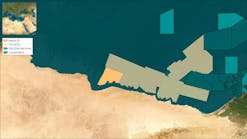Gene Kliewer • Houston
EAGE kicks off round of new products
The European Association of Geoscientists & Engineers (EAGE) annual meeting has generated more than the usual number of new product introductions. Some of them were equipment oriented such as CGGVeritas’ BroadSeis streamer system and Spectraseis borehole receiver. Most of the introductions were computer oriented. The following takes a quick look at some of these exploration aids, and starts with the equipment side.
TheCGGVeritas BroadSeis officially came out of the company’s Paris headquarters. BroadSeis is given as an integrated service resulting in high-resolution marine seismic returns. It is based on deploying Sercel Sentinel solid streamers in specific configurations in combination with new imaging technology. CGGVeritas says the system allows recording of an extra octave or more of low frequencies.
“This fully 3D solution is ideal for wide-azimuth acquisition as well as reservoir imaging and characterization in general,” says Robert Brunck, chairman and CEO of CGGVeritas. “It is also immediately available on all CGGVeritas solid streamer vessels, which make up most of our fleet. BroadSeis creates remarkable images of the subsurface and represents a new technological advance in seismic imaging.”
The borehole tool fromSpectraseis is a receiver array for low-frequency and microseismic measurements. The 4.4-in. OD tool has six levels of active receivers is designed to be deployed and recovered on a tubing string in casing as small as 5 1/2 in. and in temperatures to 160 °F (70 °C).
Other features include broadband recording, multi-level array, and a gimbaling mechanism to allow for accurate measurements in wells deviated up to 24°.
At EAGE proper,Emerson Process Management launched Roxar Tempest 6.6 integration program for “full field reservoir simulation.” This is the latest version of the Tempest program and covers preparation and analysis of original data, compositional and black-oil simulation, results study and visualization, and economic evaluation.
Specific features of the new version include advanced processing capabilities, intuitive visualization through a consistent, powerful graphical interface, and an integrated workflow. The result is increased productivity and accessibility within reservoir asset teams.
While not yet an offshore use item,Shell and PGS announced plans to develop an ultra-high channel count fiber-optic seismic sensing system. The potential for migration to offshore use should be high. The collaboration says the results of higher channel counts with high-quality sensors will recover more seismic energy and help cancel noise for improved resolution and imaging.
Display from Roxar Tempest 6.6.
Using the new system based on PGS’ OptioSeis should overcome issues with scaling up the number of channels and also lower the weight of the cable to ease deployment.
Petrosysshowed its new version of its petroleum EP mapping and data management software, 16.8. The company says this version adds the ability to directly display interpreted faults, seismic times, and other attributes from a range of workstations. The seismic and fault posting options can overlay information from a range of data sources.
Multiple scenarios
Petrosys 16.8 surface modeling now supports more advanced arithmetic formulae with conditional statements, as well as the ability to create and publish maps from within a surface modeling task. Extensions make it easier to run multiple scenarios, such as in velocity modeling, and for the routine creation and update of collections of maps and surface modeled data.
JOA Oil & Gas BV announced Impala, its new multiple point statistics (MPS) facies modeling module.
“MPS is rapidly becoming the tool of choice for facies modeling in the E&P industry,” says Gerard de Jager, CEO of JOA Oil & Gas. “With our Impala plug-in, JewelSuite brings the full power of MPS technology for advanced facies modeling to the market.”
Geology and geophysics news
Electromagnetic Geoservices has won a $150-million, multi-year contract to supply one of its purpose-built 3D electromagnetic survey vessels on a continuing basis to an operating company.
EMGS says contract signing is expected in two weeks and mobilization of the vessel by the end of August.
“This award, by far the largest ever within marine EM, is a giant step forward for EMGS,” says Roar Bekker, EMGS CEO. “A long-term project such as this provides us with a solid platform for future growth and allows us to manage our vessel utilization far more efficiently.”
CGGVeritas says it has signed a technology cooperation agreement with Petrobras to collaborate on development and implementation of new geophysical technologies. The three-year term referenced 4D seismic processing, imaging, and reservoir geophysics.
CGGVeritas recently opened a technology center in Rio de Janeiro that also plans to develop partnerships with universities in Brazil.
GoM survey now complete
PGS says data should be available late this year from its recently completed Crystal III survey of the Western Gulf of Mexico. PGS is applying its velocity modeling and RTM imaging.
The wide-azimuth towed streamer survey covered 485 deepwater OCS blocks, or a total of 11,300 sq km (4,363 sq mi).
“Initial data quality is extremely promising and we believe that the program will deliver on its promise of a step-change in imaging quality necessary to unlock the Miocene and Lower Paleogene sub-salt potential in the East Breaks area,” says Nathan Oliver, regional president of MultiClient NSA.






